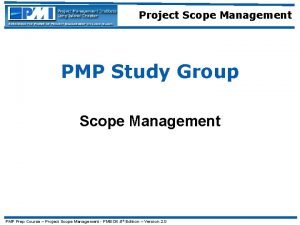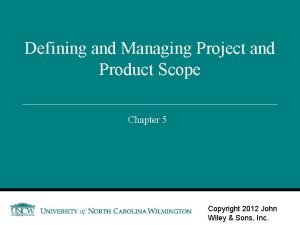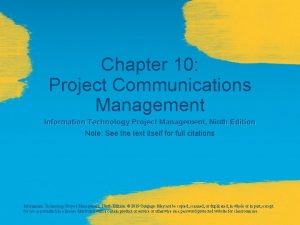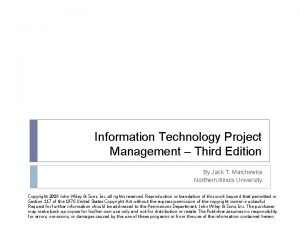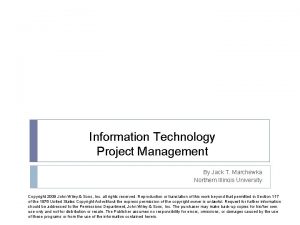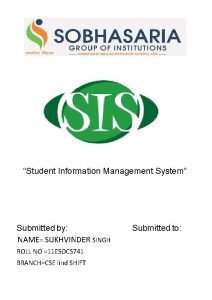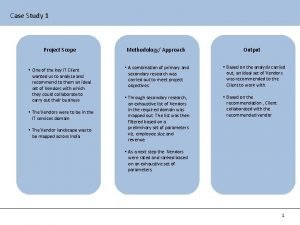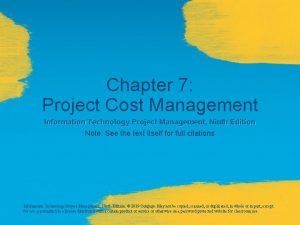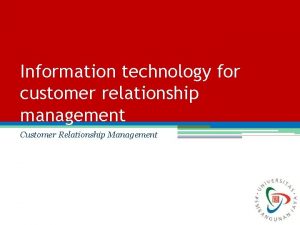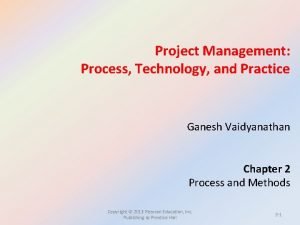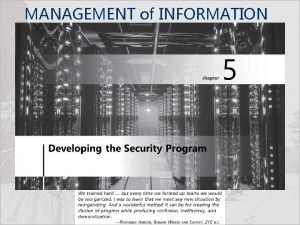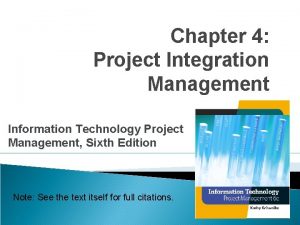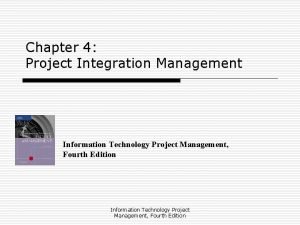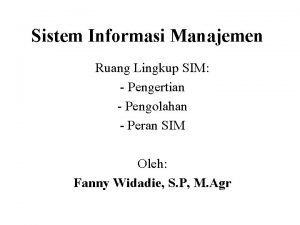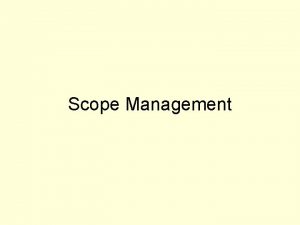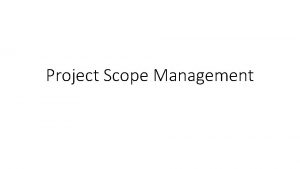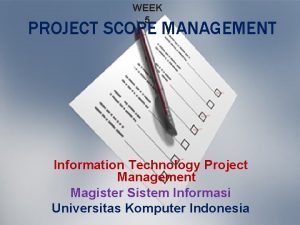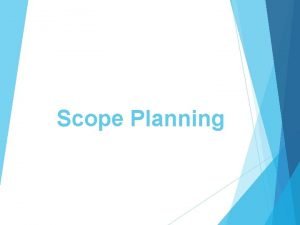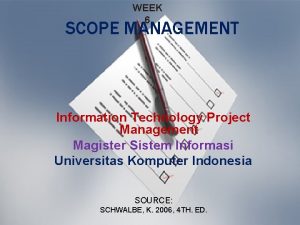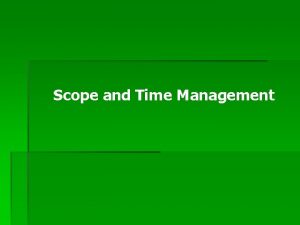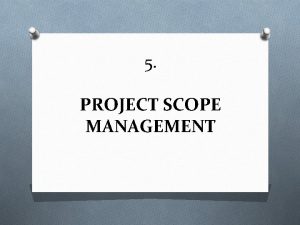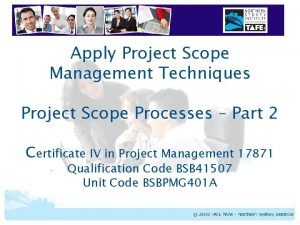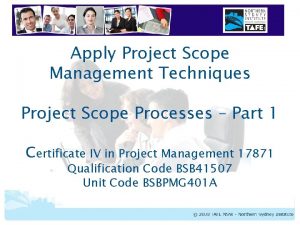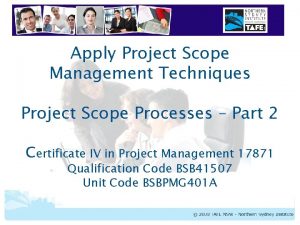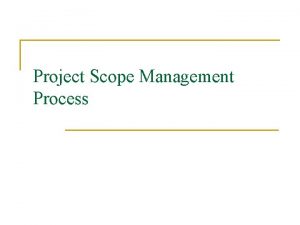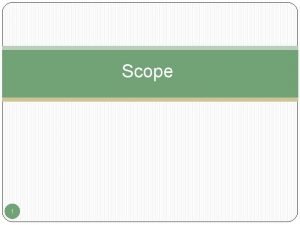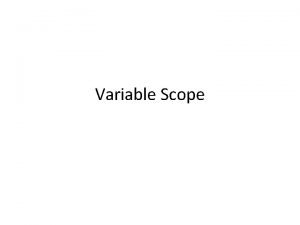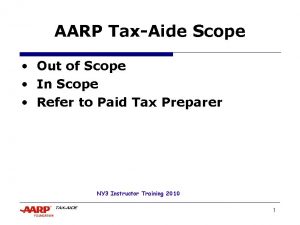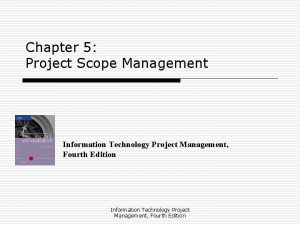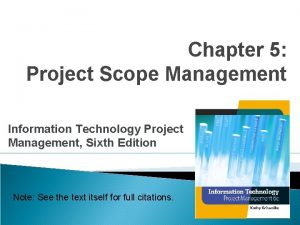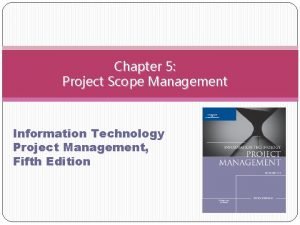WEEK 6 SCOPE MANAGEMENT Information Technology Project Management


























- Slides: 26

WEEK 6 SCOPE MANAGEMENT Information Technology Project Management Magister Sistem Informasi Universitas Komputer Indonesia SOURCE: PINTO, J. K. 2010, 2 ND. ED.

IT PROJECT FAILURE � An article by Smith, Keil, and Depledge highlight one of the mysteries of IT project failure; that is, the fact that “runaway” IT projects are often made even worse by unwillingness of project team members to convey negative information or bad news regarding the project’s status. They cite the unhappy history of the CONFIRM computerized reservation developed as a joint venture between Marriott, Hilton, and Budget Rent A Car in 1987. After almost four years and the cost over $125 million, the project was finally canceled due, in no small part, to the fact that the project team charged with its development had “deliberately concealed a number of important technical and performance problem. ” In May of 1992, two months before the project was canceled, one of the key members of consortium’s top management team charged these willful deceptions regarding the true nature of project’s status had “created more difficult problems-of both business ethics and finance-than would have existed if those people had come forward with accurate information.

PROJECT SCOPE � is everything about a project – work content as well as expected outcomes. Project scope consist of naming all activities to be performed, the resources consumed, and the end product that result, including quality standard. Scope includes a project goals, constraints, limitations.

SCOPE MANAGEMENT � is the function of controlling a project in terms of its goals and objectives through the processes of conceptual development, full definition, execution, and termination. � It’s a dream until you write it down. Then it’s goal

ELEMENT IN PROJECT SCOPE MANAGEMENT � Conceptual development � Scope statement � Work authorization � Scope reporting � Control systems � Project closeout

CONCEPTUAL DEVELOPMENT � � � is the process that addresses project objectives by finding the best ways to meet theory. To create an accurate sense of conceptual development for a project, the project management team must collect data and develop several pieces of information. Key steps in information development are: 1. Problem or need statements 2. Information gathering 3. Constraints 4. Alternative analysis 5. Project objectives 6. Statement of work

STATEMENT OF WORK � is a detailed narrative description of the work required for a project. A statement of work is an important component of conceptual development as it identifies a need within the firm or an opportunity from an outside source, for example, the commercial market.

COMPREHENSIVE SOW ELEMENTS

COMPREHENSIVE SOW ELEMENTS (CONTINUED)

SCOPE STATEMENT The heart of scope management, reflects a project teams lest efforts at creating the documentation and approach of all important project parameters prior to proceeding to the development phrase.

KEY STEPS IN SCOPE MANAGEMENT PROCESS � Establishing the project goal criteria: cost, schedule, performance, delivered les, and key receives and approach ‘gates’ with important project stakeholders (client). � Developing the management plan for the project: organization structure, policies and procedures, job description, reporting structure. � Establishing a Work Breakdown Structure: devides the project into its component sub steps in order to begin establishing critical interrelationship among activities.

WORK BREAKDOWN STRUCTURE � is a deliverable-oriented grouping of project elements which organizes and defines the total scope of the project. WBS is a process that sets a project scope by breakdown its overall mission into a cohesive set of syndrome, increasingly specific tasks.

GOAL SETTING WITH & WITHOUT WBS

IT INSTALLATION FLOWCHART

EXAMPLE OF WBS FOR A PROJECT

THE ORGANIZATION BREAKDOWN STRUCTURE � OBS allows companies to define the work to be accomplished and assign it to the owners of the work packages. The budget for these activities are then directly assigned to the departmental accounts responsible for the project work.

THE INTERSECTION OF THE WBS AND OBS

RESPONSIBILITY ASIGNMENT MATRIX � To identify personnel who will be directly responsible for each tasks in the project’s development. � The RAM is sometimes referred to as linear responsibility chart, although it is considered a separate document, the RAM is often developed in conjunction with creating the WBS for a project.

EXAMPLE OF COST & PERSONAL ASSIGNMENTS MATRIX

WORK AUTHORIZATION � � is the step that reflects the formal “go a head” given to the project to commence once the scope definition, planning documents, management plans, and offer contractual documents have been prepare and approved. Contractual documentation posses some keep identifiable features: - Contractual requirements: Specific functionality or performance criteria. - Valid consideration: What items are voluntarily promised in exchange for a reciprocal commitment by another party? Dose the work authorization contract make dear the commitment agreed to by both parties? - Contracted terms: What are excusable delays, allowable costs, statements of liquidated damages in the case of ……. performance? What are the criteria for inspection? Who has responsibility for correction of defects?

SCOPE REPORTING � fulfills the project team and key client about their needs for project updates, how many will they required, and how frequently? By determining the types of information that will be regularly reported, who will receive copies of this information, and how this information will be acquired and disseminated.

PROJECT REPORTING PARAMETER Cost Status: Update on budget performance - S Curves: Graphical displays of costs (including laborious and offer costs) against project schedule - Earned Value: Reporting project status in terms of both cost and time (the budget value of work performed regardless of actual costs incurred). - Variance or Exception Reports: Documenting any slippages in time, performance, or cost against planed measures � Schedule Status: Updates on schedule adherence. � Technical Performance Status: Updates on technical challenges and solutions. �

CONTROL SYSTEM �A famous question once asked: “How does a project become one year later? ” The answer was, “one day at a time. ” � Control System is vital to ensure that any changes to the project baseline are conducted in a systematic and through manner.

CONTROL SYSTEM � � � Configuring Control: Includes procedures that monitor emerging project scope against the original scope. Design Control: Relates to systems for monitoring the project’s scope, schedule, and costs during the design stage. Trend Monitoring: is the process of tracking the estimated costs, schedules, and resources needed against those planned. Document Control: Ensures that important documentation is compiled and disseminated in an orderly and timely fashion. Acquisition Control: Monitor systems used to acquire necessary project equipment, materials, or services needed for project development and implementation. Specification control ensures that project specifications are prepared clearly, communicated to all concerned parties, and changed only with proper authorization.

PROJECT CLOSEOUT � � The Project closeout step requires project managers to consider the types of records and reports, they and their clients will requires at the completion of project. Closeout documentation are: 1. Historical Record: As the project documentation that can be used to predict trends, analyze feasibility, and highlight problem areas for similar future project, may be kept. 2. Post project Analysis: Which follows as formal reporting structure, including analysis and documentations of the project’s performance in terms of cost, schedule adherence, and technical specification performance, may be prepared. 3. Financial closeout, or the accounting analysis of how founds were dispered on the project, may be produced.

 Process scope definition
Process scope definition Use case diagram
Use case diagram Information technology project management 9th edition
Information technology project management 9th edition Information technology project management 9th edition ppt
Information technology project management 9th edition ppt Project management quality control
Project management quality control Project management chapter 6
Project management chapter 6 Information technology project management 9th edition
Information technology project management 9th edition Information technology project management
Information technology project management Information technology project management
Information technology project management Week by week plans for documenting children's development
Week by week plans for documenting children's development Scope of student information system
Scope of student information system Traditional vs modern project management
Traditional vs modern project management Example of project scope statement
Example of project scope statement Introduction of gym management system
Introduction of gym management system Project scope management case study
Project scope management case study Project scope management powerpoint template
Project scope management powerpoint template It project scope management
It project scope management Information technology cost management
Information technology cost management Enterprise and global management in mis
Enterprise and global management in mis Information technology resource management
Information technology resource management Information technology and customer relationship management
Information technology and customer relationship management Project management process technology and practice
Project management process technology and practice Project 6 week 5
Project 6 week 5 Project management for information security
Project management for information security Project management information system example
Project management information system example Project management information system example
Project management information system example Scope of information
Scope of information
